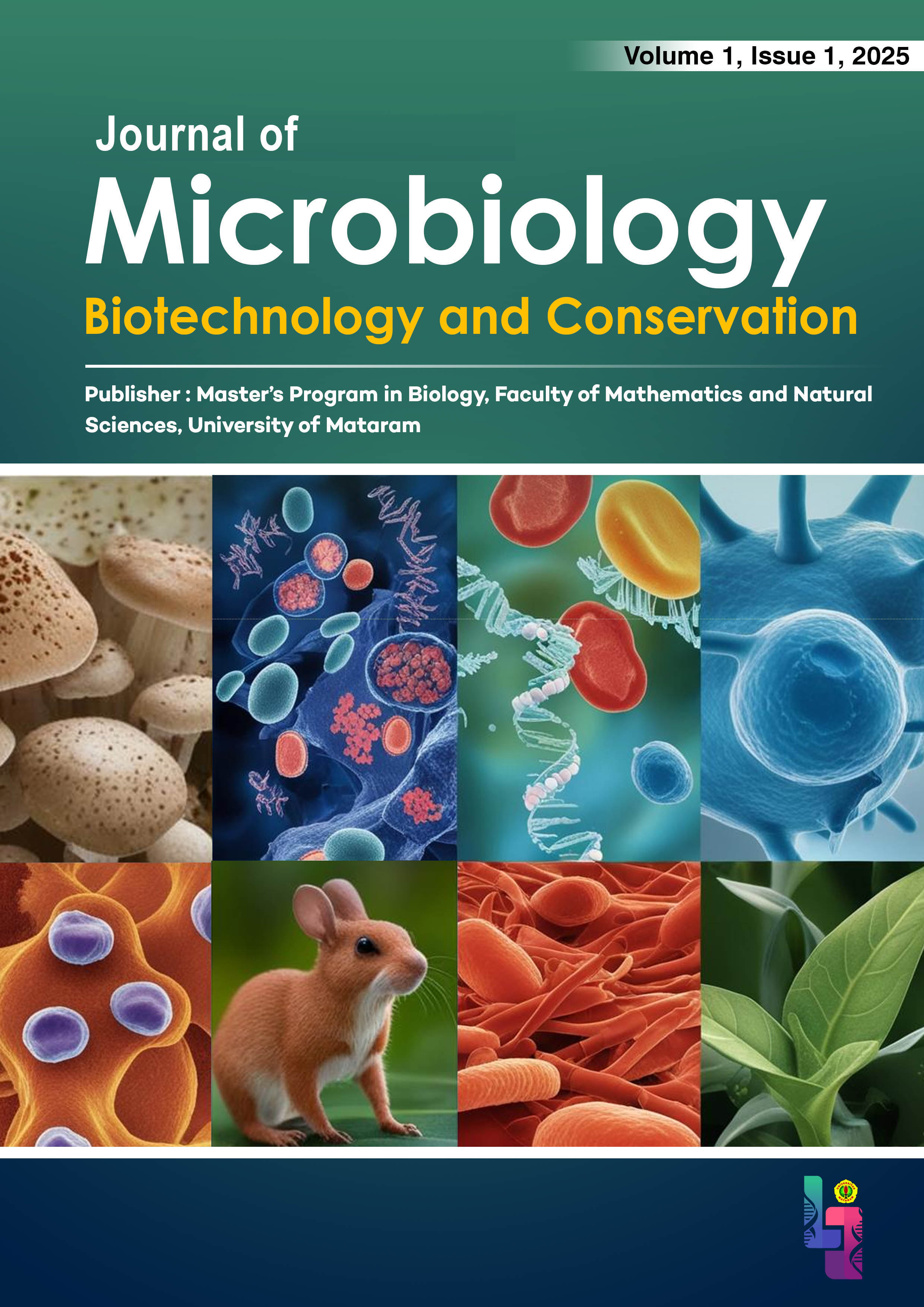
Keanekaragaman Artropoda Predator pada Tanaman Kentang (Solanum tuberosum L.) yang Diaplikasikan Pestisida Nabati Batang Tembakau dan Mimba
DOI:
10.29303/jmbc.v1i2.6111Diterbitkan:
2025-04-10Terbitan:
Vol 1 No 2 (2025): Journal of Microbiology, Biotechnology and Conservation (jMBC)Kata Kunci:
Dominance, Evenness, Abundance, AbamectinArticles
Unduhan
Cara Mengutip
Abstrak
This study aims to determine the diversity, evenness, dominance and abundance of predatory arthropods in potato plants that have been applied with plant pesticides from tobacco stems and neem. This research was conducted in June-August 2022 on land owned by farmers in the Sembalun Bumbung area, Sembalun District. This study used an experimental method with field and laboratory experiments. The experimental design used in this study was RAK (Randomized Block Design) with 4 treatments (control, chemical pesticide abamectin, tobacco pesticide and neem pesticide) with 4 repetitions. Observations in the field were carried out 10 times with an interval of 1 time a week. The results of this study found 26 species of predatory arthropods belonging to 18 Families, 7 Orders and 2 Classes. The total number of individual predatory arthropods found was 662 individuals. The value of the diversity index (H') ranges from 1.59-1.88 which is classified as moderate. The value of the € evenness index ranges from 0.49-0.59 which is quite even. Dominance index values (D) ranged from 0.21-0.31 which indicated that no single species was too dominating. Abundance index (K) values ranged from 14,898-32,345 with the highest abundance in the neem plant pesticide treatment. The results of the ANOVA test analysis showed that all treatments had significant differences, so a BNJ (Honest Significant Difference) follow-up test was carried out with a level of 5%. Further test results showed no significant differences in diversity, evenness and dominance, but significantly different in abundanceReferensi
Arsi, Anafiotika, R., Suparman, Fauziah, Z., Zhafirah, A. M., Margareta, G., Rani, F. D., Wardani, A., & Yusniawan, M. T. (2024). INTENSITAS SERANGAN HAMA DAN PENYAKIT CABAI RAWIT DI PROVINSI SUMATERA SELATAN . PROSIDING SEMINAR NASIONAL PERTANIAN PESISIR, 2(1), 535–547. Retrieved from https://semnas.bpfp-unib.com/index.php/SENATASI/article/view/224
Basri, R., & Ansari, M. S. (2021). Analytical study of phenotypic and biochemical attributes of onion cultivars in relation to infestation of onion thrips, Thrips tabaci. Journal of Asia-Pacific Entomology, 24(3), 529-535. https://doi.org/10.1016/j.aspen.2021.04.003
Chandel, R. S., Chandla, V. K., Verma, K. S., & Pathania, M. (2022). Insect pests of potato in India: biology and management. In Insect pests of potato (pp. 371-400). Academic Press. https://doi.org/10.1016/B978-0-12-821237-0.11001-7
Dinas Pertanian dan Perkebunan NTB. 2022. Rekapitulasi Luas Panen , Produktivitas dan Produk Kentang di Provinsi NTB. https://katalog.satudata.go.id/pl/dataset/rekapitulasi-luas-panen-produktivitas-dan-produksi-kentang-di-provinsi-ntb
Erlangga, K. A. (2023). Analisis Daya Saing Ekspor Produk Kentang Indonesia Terhadap Pasar ASEAN: Bahasa Indonesia. Jurnal Multidisiplin Indonesia, 2(8), 1840-1855. https://doi.org/10.58344/jmi.v2i8.358
Fauzan, L. A., Sarjan, M., Supeno, B., & Hari Aditia Pratama, M. (2025). Spider Diversity in Potato Plants Applied with Some Concentrations of Botanical Pesticides Virginia Tobacco Stem Waste. Lombok Journal of Microbiology, Biotechnology and Conservation, 1(1), 41–47. Retrieved from https://journal.unram.ac.id/index.php/ljmb/article/view/6071
Halwiyah, L., Yulianti, A., Maulidina, N. S., Akbar, M. M. I., Ramadhan, A., Sobah, N. N., ... & Avivi, S. (2024). Pelatihan Pembuatan Pestisida Nabati Solusi Pengendalian Hama Thrips Petani Muda Desa Sukowiryo Kecamatan Jelbuk. AJAD: Jurnal Pengabdian kepada Masyarakat, 4(2), 438-445. https://doi.org/10.59431/ajad.v4i2.361
Intarti, D. Y., Kurniasari, I., & Sudjianto, A. (2020). Efektivitas agen hayati Beauveria bassiana dalam menekan hama Thrips sp. pada tanaman cabai rawit (Capcisum frutescens L.). Agrovigor: Jurnal Agroekoteknologi, 13(1), 10-15. https://doi.org/10.21107/agrovigor.v13i1.5621
Mouden, S., & Leiss, K. A. (2021). Host plant resistance to thrips (Thysanoptera: Thripidae)–current state of art and future research avenues. Current Opinion in Insect Science, 45, 28-34. https://doi.org/10.1016/j.cois.2020.11.011
Nuraeni, Y., & Darwiati, W. (2021). Pemanfaatan Metabolit Sekunder Tumbuhan Sebagai Pestisida Nabati Pada Hama Tanaman Hutan. Jurnal Galam, 2(1), 1-15. Reterived from: https://www.academia.edu/download/107095525/5380.pdf
Prabowo H., Janis D., Elda N., & Sri A. (2024). Diversifikasi Tembakau Sebagai Pestisida Nabati Untuk Mendukung Pertanian Berkelanjutan. Warta BSIP Perkebunan, 2(1), 1-6. DOI:https://epublikasi.pertanian.go.id/berkala/wartabun/article/view/3505
Rahman, M. A., Rozi, I. F., & Hani'ah, M. (2024). Sistem Pakar Diagnosa Hama Penyakit Tanaman Kentang Dengan Metode Forward Chaining. Jurnal Komtika (Komputasi dan Informatika), 8(1), 33-42. https://doi.org/10.31603/komtika.v8i1.11128
Rahmawati, E. D., Rahmadhini, N., & Wuryandari, Y. (2023). Pengaruh Pemberian Pestisida Nabati Tanaman Tembakau dan Brotowali terhadap Tingkat Kerusakan Hama Kutu Hijau pada Tanaman Kopi Varietas Robusta di Desa Dompyong, Kecamatan Bendungan Kabupaten Trenggalek. Jurnal Ilmiah Universitas Batanghari Jambi, 23(1), 949-957. http://dx.doi.org/10.33087/jiubj.v23i1.3020
Renfiyeni, R., Afrini, D. ., Mahmud, M., Nelvi, Y. ., Harissatria, H., Surtina, D. ., & Elinda, F. . (2023). PENGENDALIAN HAMA DAN PENYAKIT TANAMAN CABAI SERTA NILAI AMBANG EKONOMI DI NAGARI PANINGGAHAN, KECAMATAN JUNJUNG SIRIH, KABUPATEN SOLOK. Community Development Journal: Jurnal Pengabdian Masyarakat, 4(2), 4952–4961. https://doi.org/10.31004/cdj.v4i2.15691
Safitri, B., Putri, S. U. ., Febria, D., & Darma, W. A. . (2024). Intensitas Serangan Kutu Kebul pada Tanaman Tomat dengan pemberian Pestisida Nabati Berbahan Dasar Daun Tembakau : Intensity of Whiteflies Attacks on Tomato with The Application of Tobacco-Based Botanical Pesticides. Gontor Agrotech Science Journal, 10(2), 165–172. https://doi.org/10.21111/agrotech.v10i2.12873
Sari, D. E., & Ridwan, S. (2022). Efektivitas Beberapa Pestisida Nabati Terhadap Populasi Thrips sp. pada Tanaman Cabai. Perbal: Jurnal Pertanian Berkelanjutan, 10(2), 299-304. https://doi.org/10.30605/perbal.v10i2.1856
Sarjan, M., Fauzi, M. T., Thei, R. S. P., & Windarningsih, M. (2021). Pemanfaatan Pestisida Nabati Dari Limbah Batang Tembakau Virginia Untuk Mengendalikan Hama Penting Tanaman Kentang Di Sembalun. Jurnal Pepadu, 2(2), 149-156. Reterived from: https://journal.unram.ac.id/index.php/pepadu/article/download/2178/888
Sarjan, M., Fauzi, M. T., Thei, R. S. P., & Wirdianingsih, M. (2020). Pengenalan Pestisida Nabati Dari Limbah Batang Tembakau Virginia Untuk Mengendalikan Hama Kutu Kebul (Bemisia Tabaci) Pada Tanaman Kentang. Jurnal Pengabdian Magister Pendidikan IPA, 3(2). https://doi.org/10.29303/jpmpi.v3i2.508
Sarjan, M., Thei, R. S. P., Windaringsih, M., Haryanto, H., & Supeno, B. (2022). Intensitas serangan hama pada tanaman kentang yang dibudidayakan dengan perbanyakan stek pucuk. Prosiding SAINTEK, 4, 232-245. Reterived from: https://jurnal.lppm.unram.ac.id/index.php/prosidingsaintek/article/download/499/486
Tiwari, A., Tikoo, S. K., Angadi, S. P., Kadaru, S. B., Ajanahalli, S. R., & Vasudeva Rao, M. J. (2023). Plant breeding: Its evolution and recent trends. In Market-Driven Plant Breeding for Practicing Breeders (pp. 1-32). Singapore: Springer Nature Singapore. https://doi.org/10.1007/978-981-19-5434-4_1
Vandalisna, V., Mulyono, S., & Putra, B. (2021). PENERAPAN TEKNOLOGI PESTISIDA NABATI DAUN PEPAYA UNTUK PENGENDALIAN HAMA TERUNG: Application of Papaya Leave Vegetable Pesticide Technology for Eggplant Pest Control. Jurnal Agrisistem, 17(1), 56-64. https://doi.org/10.52625/j-agr.v17i1.194
Wahyuni, S. N., Sudarmawan, A. A., & Sudantha, I. M. (2025). Potensi of Tobacco Stem Insecticide as Pest Control in Crops. Jurnal Biologi Tropis, 25(1), 689-698. http://doi.org/10.29303/jbt.v25i1.8053
Biografi Penulis
M. Muslihan Rizky, University of Mataram
Muhammad Sarjan, Universitas Mataram
Ruth Stella Petrunella Thei, Universitas Mataram
Lisensi
Hak Cipta (c) 2025 M. Muslihan Rizky, Muhammad Sarjan, Ruth Stella Petrunella Thei

Artikel ini berlisensiCreative Commons Attribution-ShareAlike 4.0 International License.







